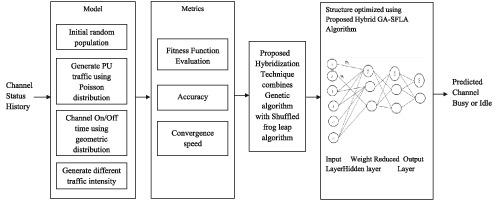当前位置:
X-MOL 学术
›
Int. J. Commun. Syst.
›
论文详情
Our official English website, www.x-mol.net, welcomes your feedback! (Note: you will need to create a separate account there.)
Hybrid genetic and shuffled frog‐leaping algorithm for neural network structure optimization and learning model to predict free spectrum in cognitive radio
International Journal of Communication Systems ( IF 2.1 ) Pub Date : 2020-07-08 , DOI: 10.1002/dac.4532 P. Supraja 1 , S. Babu 2 , V.M. Gayathri 1 , G. Divya 1
International Journal of Communication Systems ( IF 2.1 ) Pub Date : 2020-07-08 , DOI: 10.1002/dac.4532 P. Supraja 1 , S. Babu 2 , V.M. Gayathri 1 , G. Divya 1
Affiliation

|
Cognitive radio, which is called an intelligent radio, will dynamically access the available spectrum. This mechanism will bring revolt in wireless communication, which lightens the spectrum utilization problem. Machine learning plays a vital role in every technology. Here, in cognitive radio, it helps train the model to predict the free spectrum. The cognitive clients utilize range‐detecting procedures to detect the groups previously transmitting on them to stay away from impact with the authorized clients that prompts deferral and moderates more vitality. To decrease postponement and vitality utilization and to foresee the future use of channels, range expectation procedures are utilized. Spectrum prediction is used to anticipate the future channel status in light of gathered chronicled information; here, to take care of the issue, the neural system‐based spectrum prediction utilizes a backpropagation training model that has been proposed. To enhance the structure of the neural system and to decrease the forceful weight auxiliary pattern, genetic algorithm (GA) along with the hybrid combination of shuffled frog‐leaping algorithm (SFLA) is proposed. Here, GA has been utilized to abstain from catching nearby ideal solutions. The selection, crossover, and mutation functions were performed to build the haphazardness, which stretches out the populace unite to the set that contains the global ideal solution. SFLA has been proposed for structure improvement; the paired structure has been recommended to demonstrate the memes with the motivation behind building up a subaccumulation with lesser measurements than that of the original group where recognizing affectability and precision would be versatile with that of the primary status. Simulation results show the GA‐SFLA‐based hybrid algorithm that is used has increased the results of getting the best weights by improving the system; additionally, the proposed conspire results show high forecast accuracy.
中文翻译:

混合遗传和改组蛙跳算法的神经网络结构优化和学习模型,用于预测认知无线电中的自由光谱
认知无线电(称为智能无线电)将动态访问可用频谱。这种机制将在无线通信中引起反抗,从而减轻频谱利用问题。机器学习在每种技术中都起着至关重要的作用。在这里,在认知无线电中,它有助于训练模型以预测自由光谱。认知客户使用范围检测程序来检测先前在其上传播的组,以免与授权客户产生影响,从而避免延期并缓解更大的活力。为了减少延迟和活力利用,并预测渠道的未来使用,使用了范围期望程序。频谱预测用于根据收集的历史记录信息来预测未来的信道状态;在这里,照顾这个问题,基于神经系统的频谱预测利用了已经提出的反向传播训练模型。为了增强神经系统的结构并减少强制权重辅助模式,提出了遗传算法(GA)以及混洗蛙跳算法(SFLA)的混合组合。在这里,GA已被用于避免捕获附近的理想解决方案。执行选择,交叉和变异函数以构建随机性,从而将民众团结扩展到包含全局理想解决方案的集合。已经提出了SFLA以改善结构;建议使用配对结构来说明模因,其动机是建立次蓄积,其度量要小于原始组,后者在识别影响力和精确度方面与原始状态相比具有多种用途。仿真结果表明,基于GA‐SFLA的混合算法通过改进系统提高了获得最佳权重的结果;此外,拟议的conspire结果显示出较高的预测准确性。
更新日期:2020-07-08
中文翻译:

混合遗传和改组蛙跳算法的神经网络结构优化和学习模型,用于预测认知无线电中的自由光谱
认知无线电(称为智能无线电)将动态访问可用频谱。这种机制将在无线通信中引起反抗,从而减轻频谱利用问题。机器学习在每种技术中都起着至关重要的作用。在这里,在认知无线电中,它有助于训练模型以预测自由光谱。认知客户使用范围检测程序来检测先前在其上传播的组,以免与授权客户产生影响,从而避免延期并缓解更大的活力。为了减少延迟和活力利用,并预测渠道的未来使用,使用了范围期望程序。频谱预测用于根据收集的历史记录信息来预测未来的信道状态;在这里,照顾这个问题,基于神经系统的频谱预测利用了已经提出的反向传播训练模型。为了增强神经系统的结构并减少强制权重辅助模式,提出了遗传算法(GA)以及混洗蛙跳算法(SFLA)的混合组合。在这里,GA已被用于避免捕获附近的理想解决方案。执行选择,交叉和变异函数以构建随机性,从而将民众团结扩展到包含全局理想解决方案的集合。已经提出了SFLA以改善结构;建议使用配对结构来说明模因,其动机是建立次蓄积,其度量要小于原始组,后者在识别影响力和精确度方面与原始状态相比具有多种用途。仿真结果表明,基于GA‐SFLA的混合算法通过改进系统提高了获得最佳权重的结果;此外,拟议的conspire结果显示出较高的预测准确性。



























 京公网安备 11010802027423号
京公网安备 11010802027423号